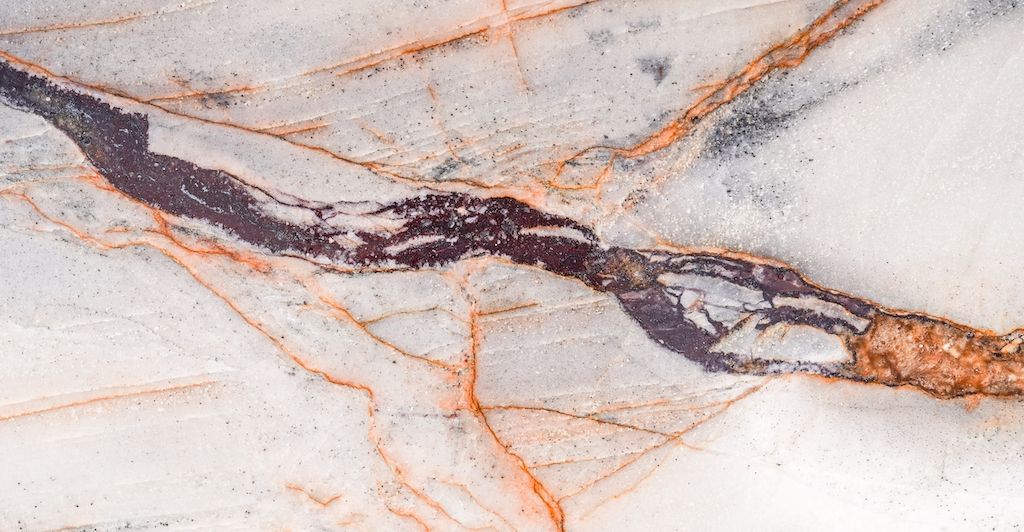What is sintered stone made of?
Sintered stone is an engineered stone that contains natural materials, including clay, feldspars, kaolin and silico-aluminates. During the manufacturing process, these materials are then processed into a mixture that is then exposed to extreme pressure and high heat.
The result is a stone that's compact, durable, resistant and versatile.
What does sintered stone look like?
 One reason this type of stone is so popular is that it can fit just about any aesthetic you're going for. You can choose from a variety of colors, prints, designs and textures. Sintered stone can also mimic the appearance of marble and natural stone.
One reason this type of stone is so popular is that it can fit just about any aesthetic you're going for. You can choose from a variety of colors, prints, designs and textures. Sintered stone can also mimic the appearance of marble and natural stone.
Where to use sintered stone around the home.
Because of its robust and hardy nature, it's equally suited for indoor and outdoor use. Here are a few of the main uses of sintered stone.
Indoor projects:
- Bathroom and kitchen countertops
- Bathroom vanities
- Cabinets
- Coffee tables
- Dining tables and other tabletops
- Facades
- Flooring
- Shelves
- Sinks
Exterior and landscaping projects:
- Patios
- Stepping stone pathways
- Swimming pool decks
- Walkways
- Wall cladding
Related: What is flagstone? Everything you need to know.
Advantages and disadvantages of sintered stone.
Sintered stone is very hardy and has many benefits — but it also has its drawbacks. Here are the main pros and cons:
Pros | Cons |
Heat and scratch-resistant | Has a larger environmental footprint (compared to natural stone) |
Low maintenance (non-porous, doesn’t require sealing and easy to clean) | Prone to damage due to impact (particularly around the edges) |
Versatile applications and uses | Chips or cracks on edges are difficult to repair |
Available in many colors, designs and textures | Textures and printed designs may only cover the surface area of one side of the slab |
Sintered stone is heat and scratch-resistant. You don't need to worry about damaging the surface when you put hot pans onto the surface, making it an excellent choice for kitchen countertops.
You may also like sintered stone because it's low maintenance and easy to clean. Its non-porous nature means it doesn't need to be sealed. And you can find it in a large variety of colors, textures and designs, such as those mimicking marble, granite or other natural stone looks.
On the downside, sintered rock is prone to damage due to impact, particularly around the edges. And any chips or cracks may be difficult to repair.
Another disadvantage is that the textures and printed designs only cover the surface area of one side of the slab. For example, you'll see the prints and designs on the surface of your countertop, but it doesn't continue over the edges or underneath.
Lastly, working with sintered stone requires special tools, so it's better to hire a professional for your project than try to do it yourself.
How long does sintered stone last?
To give you an idea of how long sintered stone lasts, look at the warranty the supplier is offering you. Some companies offer warranties ranging from 10 to 25 years. Read the fine print to find out if you have a limited or full warranty.
Sintered stone cost considerations.
Sintered stone is a high-end material and may come with a heavier price tag than other material options. Ask local contractors or landscapers for price quotes before you start your project.
Start a home project using sintered stone.
If you're convinced that sintered stone is the type of stone you want for your project, download the Thumbtack app and get free estimates from home remodeling professionals, contractors or landscapers. Tell them what you’re envisioning for your home and yard, and let the pros help you bring it to life.
FAQs
Sintered stone vs. quartz — which one is better?
Sintered stone and quartz have a few similarities. For example, both are available in different styles and designs, and they don’t need to be sealed. At the end of the day, it comes down to personal preference and your budget. Compare the cost of using sintered stone and quartz for your project and ask about warranties.
A professional can give you options and free estimates for your project.
Related: How much are quartz countertops?
Is sintered stone better than granite?
It's difficult to say which is "better." Your choice ultimately comes down to personal preference and your budget.
Granite is a natural stone that’s popular for its many colors and beautiful patterns. But unlike sintered stone, it needs to be sealed to make it heat, scratch and stain-resistant. If you don’t want to worry too much about maintenance, you may want to go with sintered stone.
Related: How much do granite countertops cost?
A note about project costs included or linked in this article: Figures represent national average cost estimates using data provided by Thumbtack pros and additional research. These figures are provided for educational purposes only and are subject to change at any time due to various factors. Details about your specific project and local rates can impact costs.